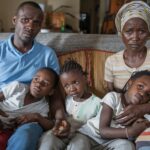Hassan* has half of a face. Yes, you heard right, half a face! You see, he wasn’t born like this. On his first birthday, his mother noticed a small sore on his mouth covered with a slimy substance. Like a lot of people in rural areas who had little health knowledge, she cleaned the sore and made a silent prayer hoping that it would disappear. When the sore persisted, she complained to some more experienced mothers, and she was reassured that ‘these were signs of teething and fever’. As the weeks went by, the sore got bigger and Hassan became very sick. This prompted his mother to find help and treatment from a traditional healer. When many visits and traditional concoctions didn’t yield the desired result, but instead his situation continued to get worse, the herbalist, having reached his wit’s end himself, referred her to the primary health care center located in the community they lived in.
By then, the sore had spread to almost half of his face and was giving off an offensive odor. The surrounding skin tissue had a black hue giving the poor boy a monstrous appearance. The presentation at the primary health care center was timely as resuscitative measures were carried out to bring Hassan back to appreciable health. However, the facial condition could not be managed at the facility, as the tissues of the face that were affected, had died. This necessitated subsequent referral to a tertiary hospital where the dead facial tissue was debrided. This left a large defect in his face that would require reconstructive surgery by the plastic team later. Hassan, like many others afflicted by this condition had started a lifelong journey of living with a condition called Noma, popularly known in Hausa vernacular as Zaizayar baki.
Noma is an acquired condition that causes the face to be eaten up by microorganisms. These microorganisms are activated when our immunity levels are low or when we lack some micronutrients within our system (malnutrition). These micronutrients are best gotten from a balanced diet, consisting of a fair amount of proteins, vegetables, and a moderate amount of carbohydrates and fats. The condition is further complicated by other risk factors like poor oral hygiene, poor uptake of immunization and poverty.
The condition usually begins as a minor gum sore and if untreated, quickly spreads to the teeth, skin, muscles, and bones of the face, killing these tissues by destroying the blood vessels. Gradually, the infection spreads to the blood stream and sepsis sets in. He or she becomes feverish, loses appetite and subsequently weight. At this point, it has become lethal. Over 90% of those who have the illness will die from sepsis. For those who live, the resulting facial deformity among survivors leaves the patient with a horrific facial appearance, burdening their mental health. In addition to depression and anxiety, they frequently report stigmatization and being socially excluded. Parents are often forced to hide their children afflicted with this condition and older ones find solace in the serenity of their abode living in abject penury. Sadly, this disease afflicts mostly the poor; the turncoats and determined ones in these group- who want a better life- are soon flattened by the reality of them not being able to lift themselves out of poverty despite their best efforts. Their forced reality clusters them into a cohort of the neo-marginalized- the poorest amongst the poor.
- New notes: Emefiele begs Nigerians to endure challenges
- Chelsea spend more than German, Spanish, French & Italian Leagues Combined!
Nomas is an oral and maxillofacial surgeon’s worst nightmare; now and again, when we interview people living with this condition, we are brought back to the difficult process of facial reconstruction. “How can I close a facial imperfection cosmetically without affecting the person’s identity?” has always been our main concern. For the most part, “We can’t” is the honest response. Due to the fact that no one has ever surpassed the Almighty Creator’s design skill, our best abilities permit a restriction on the variety of practice, thus body tissues from distant donor sites are employed for face reconstruction as our best bet, causing accompanying morbidity of these donor sites. Fortunately, improvements in surgery and medicine enable novel useful techniques like computer-assisted face models, regenerative medicine, and virtual surgical planning with successful outcomes which are as of now, prohibitively expensive to the poor Nigerian. The good news, nevertheless, is that NOMA can be avoided and if it is recognized early enough, its progression may also be slowed. The flip side to this, however, is that few individuals are able to recognize noma symptoms when it is in its early phase. These symptoms include unpleasant bad breath, poor oral hygiene, bleeding gums and a sore in the mouth.
Improving literacy on self-hygiene amongst the populace is perhaps the most important step in the direction to curb NOMA. It has been noted that an improvement in self-care especially oral hygiene curbs NOMA progression. This should be interfaced with public health education, nutrition programs and surveillance protocols which should be led by the ministry of health and NGOs. Appreciatively, the Nigerian federal ministry of health (FMOH) is at the forefront of curbing the scourge of NOMA worldwide by its creation of a well-thought-out action plan on curbing Noma via a National Noma control policy with a 5-year action plan spanning from 2019 to 2023 and is currently being updated. In addition, Nigeria through the FMOH is leading other nations of the world to advance the message that Noma should be recognized as a neglected tropical disease(NTD). Doing this brings attention to the disease Noma and commits the world to bringing an end to noma just like it did with polio. Ultimately the goal is to eradicate NOMA by 2030.
Furthermore, dealing with this scourge is a prime example of an interplay of the United Nations Sustainable Development Goals (SDGs); goal 3 (good health and well-being), goal 1(no poverty), goal 2 (no hunger), goal 6(water and sanitation) and goal 17(a partnership of the goals) to achieve desired targets. It is instructive to note that Noma still lives amongst us and it is not obsolete as most academics and scholars would want to believe. A study by Medecins Sans Frontieres (MSF) estimates that there are over 3,300 cases per 100,000 children in northern Nigeria, while another study by the World Health Organization (WHO) records 140,000 new Noma cases globally typically around the Noma belt with Nigeria leading in figures. These figures give credence to the public health issue that noma heralds.
Even as we picture what the realities of the scourge are, we should be thankful that people like Hassan have a sense of hope from advances in surgical competencies, the work of international partners like MSF who provide free surgeries, and the Nigerian ministry of health that works assiduously and overtime to ensure the bane ends.
But for now, Hassan remains hidden in a corner in his community with little or no interaction with the outside world. His mother’s reply to inquiries about his whereabouts remains “noma ate his face”.
Dr Akinlade Akinwaleola is an Oral and maxillofacial surgeon with Wellness Smiles Health Initiative and a member of the Nigerian Dental Association(NDA).
Note: Dr Fatima Damagum will be back next week

 Join Daily Trust WhatsApp Community For Quick Access To News and Happenings Around You.
Join Daily Trust WhatsApp Community For Quick Access To News and Happenings Around You.

